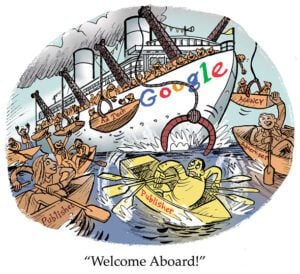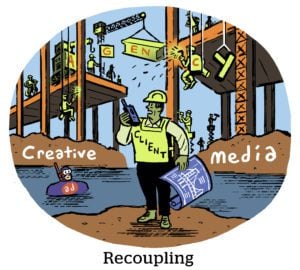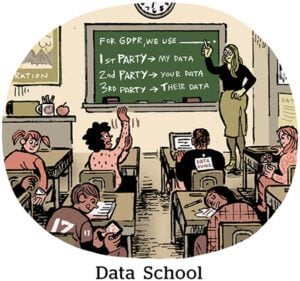The marketing industry is calling out for leadership. And CMOs are responding: “Meh.”
Marketing chiefs are accustomed to justifying their existence to the rest of the C-suite. But according to a 2022 Gartner study, fewer than half of CMOs believe they can prove the value of their organization’s efforts.
They can’t answer the basic question “What do you do?” and explain why their work matters.
At a time when most organizations question whether they even need a CMO, this ambiguity is a problem. Add a technology stack less conducive to targeted advertising (and thus, less effective), and it becomes a full-blown crisis.
But crisis is often fertile ground for change. And boy, the marketing world is in desperate need of change. If we accept the premise that the declining efficacy of marketing teams is primarily a tooling problem – specifically, that marketers have long relied on tools that don’t work and are vulnerable to fraud – the solution suddenly becomes glaringly obvious.
We need to start fresh.
The age of bullshit
Analyst house WARC estimates that the global ad spend will surpass $1 trillion in 2024, with the vast majority spent on digital channels.
But here’s the problem: Far too many organizations are spending far too much on advertising services that either don’t work, have a lower ROAS (return on ad spend) compared to the alternatives or are brand kryptonite. Or, worse, they’re easily exploited by bad actors who, by committing click fraud, siphon marketing dollars into their own back pockets.
Gartner stats placed the average corporate marketing spend in 2022 at 9.5% of total revenue. And Juniper Research estimates that 22% of all online ad spending – or $84 billion – will be lost to fraud in 2023. The situation is even more dire in the mobile sphere, where 30% of all ad clicks and impressions are fraudulent. According to Juniper, the issue isn’t merely endemic; it’s also growing proportionally to the global digital ads market, with fraud expected to swallow 23% of online ad spending by 2028.
It’s easy to identify fraud as bullshit. But what’s arguably more problematic is that we haven’t found a solution, even though tech giants faced class-action lawsuits over click fraud almost two decades ago. Juniper Research says only $23 billion worth of ad fraud (or roughly one-quarter) could be prevented through mitigation tools, leaving the rest free for the taking.
And most corporate marketers are blissfully ignorant. A 2023 survey from Omi and Ascend2 shows that only 23% of marketing leaders at medium-to-large organizations described click fraud as a concern, with 14% saying they were “unconcerned.” Just 18% said it was their leading concern, trailing other priorities, like the rise of ad blockers and the need to find the right audience for their ads.
How has a 22% fraud rate become acceptable, and why aren’t ad buyers banging on the doors of tech giants and networks demanding they do something?
For the most part, CMOs don’t care. That’s bullshit.
The value of money
Fraud is just one example of waste in the digital landscape, which is rife with ineffectiveness. There are also products that don’t really feel geared toward delivering any real kind of business ROI. The continued existence of Taboola and Outbrain remains a mystery.
And yet, these tools exist because of a genuine failure of strategy, leadership and assertiveness. CMOs struggle to prove their worth because they keep making dumb decisions.
Some – notably luxury fashion brands like Burberry and Gucci – have spent heavily in the metaverse since the pandemic, building and promoting “experiences” that few visited and didn’t drive sales. A rational voice would argue that few people in 2021 used the metaverse and the longevity of these platforms was a matter for debate. Besides a brief rush of media coverage, the metaverse offered marketers nothing.
Those rational voices were either silenced or ignored. And now, with the metaverse hype bubble deflated, they’re vindicated. Even if the money invested in these metaverse ventures was negligible, it could still have been spent on marketing channels that are proven to deliver results.
There are even examples of laziness and stupidity in other legacy channels. You can find them by turning on your TV in the early hours of the morning and seeing who’s buying ad spots during a 2 a.m. rerun of an old “The Twilight Zone” episode.
Those spots cost thousands, and, from an ROAS perspective, they’re money wasted.
The dawning age of sanity
GDPR, Apple’s AppTrackingTransparency and the death of the third-party tracking cookie have forced the marketing industry to rethink its entire approach, look candidly at tooling and figure out what works and what doesn’t.
This is a good thing. For marketers. For the companies they work for. And – even though it doesn’t seem like it – for the industry at large.
Marketers have been provided that rarest of things: a blank state from which to start anew. It’s an opportunity to expand their newfound (and perhaps reluctant) skepticism to other marketing channels and to abandon the old dogmas.
My only hope is they take full advantage of it.
“Data-Driven Thinking” is written by members of the media community and contains fresh ideas on the digital revolution in media.
Follow AdQuick and AdExchanger on LinkedIn.
For more articles featuring Chris Gadek, click here.



















